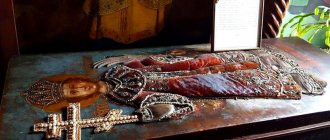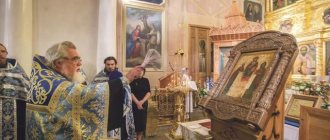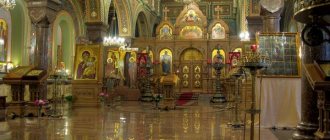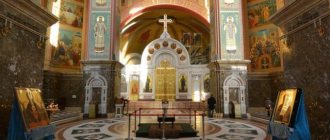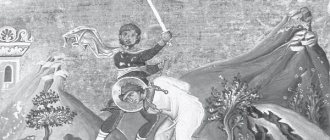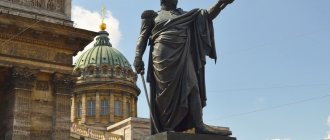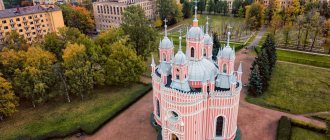Mir
Russia Sevastopol Vladimir Cathedral (Chersonese Tauride) Map loading in progress...
{"format":"leaflet","minzoom":false,"maxzoom":false,"limit":50,"offset":0,"link":"all","sort":[""], "order":[],"headers":"show","mainlabel":"","intro":"","outro":"","searchlabel":"\u2026 \u0441\u043b\u0435\ u0434\u0443\u044e\u0449\u0438\u0435 \u0440\u0435\u0437\u0443\u043b\u044c\u0442\u0430\u0442\u044b","default":"","import-annotation":false,"width ":"auto","height":"350px","centre":{"text":"","title":"""link":"""lat":44.61222000000000065256244852207601070404052734375,"lon": 33.4933300000000002683009370230138301849365234375,"icon":""},"title":"","label":"","icon":"","lines":[],"polygons":[],"circles":[ ],"rectangles":[],"copycoords":false,"static":false,"zoom":8,"defzoom":14,"layers":["OpenStreetMap"],"image layers":[] ,"overlays":[],"resizable":false,"fullscreen":true,"scrollwheelzoom":true,"cluster":false,"clustermaxzoom":9,"clusterzoomonclick":true,"clustermaxradius":80, "clusterspiderfy":true,"geojson":"","clicktarget":"","showtitle":true,"hidenamespace":false,"template":"","userparam":"","activeicon": "","pagelabel":false,"ajaxcoordproperty":"","ajaxquery":"","locations":[{"text":"\u003Cb\u003E\u003Ca href=\"/palomnik/%D0% 92%D0%BB%D0%B0%D0%B4%D0%B8%D0%BC%D0%B8%D1%80%D1%81%D0%BA%D0%B8%D0%B9_%D1%81% D0%BE%D0%B1%D0%BE%D1%80_(%D0%A5%D0%B5%D1%80%D1%81%D0%BE%D0%BD%D0%B5%D1%81_%D0 %A2%D0%B0%D0%B2%D1%80%D0%B8%D1%87%D0%B5%D1%81%D0%BA%D0%B8%D0%B9)\» title=\»\ u0412\u043b\u0430\u0434\u0438\u043c\u0438\u0440\u0441\u043a\u0438\u0439 (\u0441\u043e\u0431\u043e\u0440 441\u043e\u043d\u0435\u0441 \u0422\u0430\u0432\u0440\u0438\u0447\u0435\u0441\u043a\u0438\u0439)\»\u003E\u0412\u043b\u0430\u0434\u0438\u043c\u0438\u0440 \u0441\u043a\u0438\ u0439 \u0441\u043e\u0431\u043e\u0440 (\u0425\u0435\u0440\u0441\u043e\u043d\u0435\u0441 \u0422\u0430\u0432\u0440\u0438\u0447\u 0435\u0441\u043a\u0438\u0439 )\u003C/a\u003E\u003C/b\u003E\u003Chr /\u003E\u003Ca href=\»/palomnik/%D0%A1%D0%B2%D0%BE%D0%B9%D1%81%D1% 82%D0%B2%D0%BE:%D0%90%D0%BD%D0%BD%D0%BE%D1%82%D0%B0%D1%86%D0%B8%D1%8F\" title= \u0421\u0432\u043e\u0439\u0441\u0442\u0432\u043e:\u0410\u043d\u043d\u043e\u0442\u0430\u0446\u0438\u044f\"\u003E\u0410\u04 3d\u043d\u043e\ u0442\u0430\u0446\u0438\u044f\u003C/a\u003E: \u043f\u0440\u0430\u0432\u043e\u0441\u043b\u0430\u0432\u043d\u044b\u0439 \u0445 \u0440\u0430\u043c \u043d \u0430 \u0442\u0435\u0440\u0440\u0438\u0442\u043e\u0440\u0438\u0438 \u0425\u0435\u0440\u0441\u043e\u043d\u0435\u0441\u0430 \u0422\u0430\u0432\u0440\u0438 \u0447\u0435\u0441\u043a\u043e\u0433\u043e. \u042d\u0442\u043e \u043e\u0434\u043d\u043e \u0438\u0437 \u0441\u0430\u043c\u044b\u0445 \u0432\u044b\u0434\u0430\u044e\u044 9\u0438\u0445\u0441\u044f\u0430 \u0440\u0445\u0438\u0442\u0435\u043a\u0442\u0443\u0440\u043d\u044b\u0445 \u0441\u043e\u043e\u0440\u0443\u0436\u0435\u043d\u 0438\u0439\u0433\u043e\u0440 \u043e\u0434\u0430 \u0421\u0435\u0432\u0430\u0441\u0442\u043e\u043f\u043e\u043b\u044f, \u0445\u0440\u0430\u043c-\u043f\u043 0\u043c\u044f\u0442\u043d \u0438\u043a, \u0443\u0432\u0435\u043a\u043e\u0432\u0435\u0447\u0438\u0432\u0430\u044e\u0449\u0438\u0439 \u043f\u0440\u0438 \u043d\u044f\u0442\u0438\ u0435 \u0445\u0440\u0438\u0441\u0442\u0438\u0430\u043d\u0441\u0442\u0432\u0430 \u043a\u043d\u044f\u0437\u0435\u043c \u0412\u 043b\u0430\u0434\u0438\u043c\ u0438\u0440\u043e\u043c.","title":"\u0412\u043b\u0430\u0434\u0438\u043c\u0438\u0440\u0441\u043a\u0438\u0439 \u0441\u043e\u0431\u0 43e\u0440 ( """link":"", "lat ":44.61222000000000065256244852207601070404052734375,"lon":33.49333000000000002683009370230138301849365234375,"icon":""}],"imageLayers" :[]}
44.565219; 33.464167
Russia, Sevastopol, Gagarinsky municipal district
Sevastopol
Russia
Telephone:
+7 (8692) 242115
St. Vladimir's Cathedral
- Orthodox church on the territory of Tauride Chersonesos. This is one of the most outstanding architectural structures of the city of Sevastopol, a temple-monument that perpetuates the adoption of Christianity by Prince Vladimir.
History[edit]
St. Vladimir's Cathedral in Chersonesus is an Orthodox shrine that perpetuated the adoption of Christianity by Prince Vladimir. The temple-monument amazes with its grandeur, beauty and proportionality of lines.
St. Vladimir's Cathedral was founded in 1861. The royal family attended the ceremony. The first stone in the foundation of the cathedral was laid by Emperor Alexander II. He also approved the project of the future temple on the territory of the Chersonesos monastery.
The author of the project was academician of architecture David Grimm. Interestingly, St. Vladimir's Cathedral in Chersonesos was the first outstanding structure designed by this architect. For his work, D. Grimm was awarded the title of professor and the right to teach at the academy.
The majestic cathedral rose 34 meters above the ground. The thickness of its walls reached a meter. The interior decoration of the temple was also striking in its splendor: mosaic floors, marble columns. Famous artists worked on the painting of the Vladimir Cathedral - academician of painting Alexey Korzukhin (one of the designers of the Cathedral of Christ the Savior in Moscow), professor Timofey Neff, Ivan Malyshev, Nikolai Maikov. The work was led by the author of the Foros Church project, academician Nikolai Chagin.
Funds for the construction of St. Vladimir's Cathedral were collected throughout Russia by subscription. When it expired, people demanded that the collection of money be extended. Due to a shortage of funds, the construction of the temple dragged on for three decades.
In 1924, the Chersonesos Monastery was closed, and the Vladimir Cathedral was transferred to the museum. During the Great Patriotic War, the temple building was badly damaged: the walls were cracked, the interior decoration was almost completely destroyed. The cathedral was in this state until recently.
The restoration of the great shrine began with the labors of the ruling bishop, His Eminence Vladyka Lazar. The problems of restoring the Vladimir Cathedral were dealt with by top-level statesmen.
In 1992, worship services resumed within the walls of the temple. In 1998, under the patronage of the President of Ukraine Leonid Danilovich Kuchma and his wife, the restoration of the cathedral began.
On May 5, 2002, an Easter service was held at St. Vladimir’s Cathedral for the first time in 77 years. The festive service was led by Bishop Lazar, Metropolitan of Simferopol and Crimea. The Easter service at St. Vladimir's Cathedral in Chersonesos was attended by the President of Ukraine Leonid Danilovich Kuchma and the leadership of the Autonomous Republic of Crimea.
On April 3, 2004, the Primate of the Ukrainian Orthodox Church, His Beatitude Metropolitan Vladimir of Kyiv and All Ukraine, in the presence of the President of Ukraine Leonid Kuchma, consecrated the restored St. Vladimir Cathedral in Chersonesos.
Today, divine services are regularly held in the St. Vladimir Cathedral, and the Sacraments of Baptism and Wedding are performed. The reception of the Sacraments is preceded by public conversations.
The lower (consecrated in honor of the Nativity of the Blessed Virgin Mary) and the upper (consecrated in honor of the Holy Equal-to-the-Apostles Prince Vladimir) churches are in operation.
What to see in the cathedral
The main attraction of the Vladimir Church is a copy of the Korsun Icon of the Mother of God. This miraculous image was created in the 1st century. According to legend, its author is the Apostle Luke. There is also a marble iconostasis, which was recreated based on surviving photographs. It contains a gilded wooden icon case and several holy images.
The majestic compositions decorating the dome from the inside have been restored in detail in the temple:
- "Epiphany";
- "Holy Spirit";
- "Transfiguration".
Around the Vladimir Church are the ruins of Chersonesos, a basilica with partially preserved columns and the remains of an ancient mosaic floor. Here are the Western Gate, Zeno's Tower, an ancient theater that once served for performances and gladiator fights. Nearby you can see another legendary landmark - a large bell, which was cast in 1776 from Turkish cannons.
Background to the construction of the Chersonesos sacred relic
The very idea to build the Vladimir Cathedral rightfully belongs to A. Greig, who was the commander of the Black Sea Fleet (in 1825 he submitted a petition to Alexander I). Initially, the idea implied the erection of a small church, as well as a shelter for God. While the decision was being made on the future construction of the temple, at the instigation of N. Kruse (he held the rank of midshipman), archaeological excavations were launched using funds collected by the sailors. The fundamental goal is to establish for sure the specific place where Prince Vladimir was baptized.
After the death of Tsar Alexander I, Nicholas I was appointed his successor, who designed the construction of a cathedral on the site of an ancient basilica (discovered during archaeological research). Thanks to these excavations, the location of the Church of the Nativity of the Mother of God was precisely established. It was in it that Prince Vladimir was baptized in 988.
A historical event for Russia (according to the memoirs of the righteous N. Chronicler) developed in the very “heart” of the city of Korsun. The first stone of St. Vladimir's Cathedral was laid by Alexander II together with his wife Alexandrovna Maria. On the occasion of such a fateful event, a sacred prayer service was held, which was attended by the entire imperial entourage.
Due to regular shortages of funds, the construction of the Chersonesos place of worship took a long time. In 1877, the auxiliary work was completed. Over the course of 11 years, financial resources were collected for interior decoration. In 1888, a Liturgy was held in honor of the 900th anniversary of the Baptism of Rus'.
Exact location on the map, GPS coordinates: 44°36'43.2″N 33°29'35.7″E (44.611993, 33.493238)
Vladimir Cathedral in Sevastopol is a unique monument of architecture, history and proof of human determination. And also the fact that holy places “don’t die”; sooner or later they come back to life, giving people a second chance. Have an interesting and enjoyable holiday everyone!
Stanislav recommends all the sights of Sevastopol
- Where to relax in January
- Where to relax in February
- Where to relax in March
- Where to relax in April
- Where to relax in May
- Where to relax in June
- Where to relax in July
- Where to relax in August
- Where to relax in September
- Where to relax in October
- Where to relax in November
- Where to relax in December
The invisible works of Archbishop Innocent
Numerous secular sources write about all this: books and websites. But they are all silent about the works of Archbishop of Kherson and Tauride Innocent (Borisov). Namely, he, “seeing the need to strengthen the religious well-being of Crimea, overrun by Islamism,” proposed to resurrect the oldest monasteries in Russia, revered according to Christian memories. “Here were the feet of the First-Called Apostle Andrew. Here the first martyr’s blood of Clement, a disciple of the Apostle Peter, and the blood of other martyrs from the first centuries of Christianity were shed for Christ and sanctified the future Christian Russia. Here our Slovenian apostles Cyril and Methodius preached the word of the Gospel. Here is the font, from which a gracious and truly beneficial light poured out onto the entire Russian land,” wrote the bishop. Through his labors, an entire monastery was founded and built on this site. One of its first churches was consecrated in honor of the seven holy martyrs of Chersonesos.
History of the bell
The bell was cast in 1776 from cannons that were captured after the war with the Turks. During the Crimean War, the French stole the bell, taking it to France, to Notre Dame Cathedral.
In 1913, the bell was returned to Russia and installed in the belfry of the Vladimir Church. The loud sound from the belfry became a beacon for ships, warning of the danger of approaching the rocky shores.
In 1925, when the monastery was closed, all the bells were removed, only one was left on the seashore to protect ships. When cleaning the bell, the clergy discovered inscriptions indicating that it was the same one returned from Paris. The inscriptions indicated that the bell was cast from the artillery of the Turks, in honor of St. Nicholas the Pleasant. Casting work was carried out in Taganrog.
In 1960, local barbarians tore out the tongue from the bell.
Only in 2004, powerful blows of a bell that survived 2 wars were heard over Sevastopol.
Chersonesos fog bell
Decoration of the Church of St. Vladimir in Chersonesos
The cathedral was made in the neo-Byzantine architectural style. A large copper bell was installed on his belfry, the money for which was given by the emperor himself. The lower part of the temple was made of gray limestone. The facades had windows in the shape of crosses, and the building was decorated with marble columns.
The interior of the cathedral was luxurious. The windows were decorated with colored glass, the floor was tiled, and many elements were made of Carrara marble. The interior of the temple was painted by many famous artists of that time. Among them was A.I. Korzukhin, who wrote “The Last Supper” for the cathedral, which became its calling card.
Divine services of St. Vladimir's Cathedral
The cathedral regularly hosts divine services, the Sacraments of Baptism and Weddings. The lower (consecrated in honor of the Nativity of the Blessed Virgin Mary) and upper (in honor of Equal-to-the-Apostles Prince Vladimir) churches are open. It is open to everyone and works seven days a week. Morning liturgy takes place at 7.30–8.30, evening worship at 17.00.
In the lower church there is an exhibition with a collection revealing the history of the cathedral, the life and work of the admirals buried in it, the work of architects, artists, builders and restorers.
Schedule of services March 2022
Shrines
Particles of the relics of Prince Vladimir and some Nizhny Novgorod saints are kept within the walls of the cathedral. Also here is an icon of the faithful spouses Peter and Fevronia and an image of the saints of the Nizhny Novgorod land.
How to get to the shrine
The Khersones Tauride complex and the Vladimir Cathedral located in it are located in the Gagarinsky district of Sevastopol. The exact address is st. Drevnyaya, 1. You can get there by buses No. 107 and No. 195, which you can board directly at the bus station. You need to go to the stop “st. Dmitry Ulyanov." Next you will have to walk about 1 km to the temple, towards the north (towards the sea).
There are 2 trolleybuses running from the railway station to the same stop – No. 6 and No. 10.
You can also get there from the final trolleybus stop “5th kilometer of Balaklava Highway”. To do this, you need to take minibus No. 22 and go to the very place - the “Khersones Tauride” stop.
Vladimir Cathedral on the map of Crimea
GPS Coordinates: 44° 36′ 43.67″ N 33° 29′ 36.43″ E Latitude/Longitude
